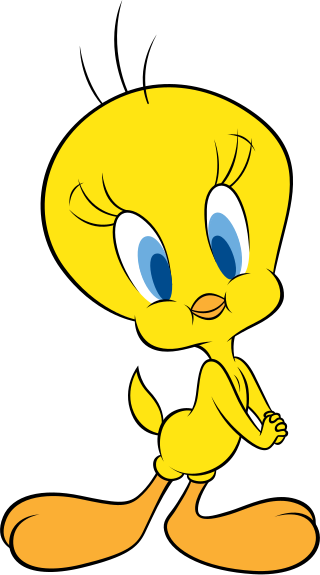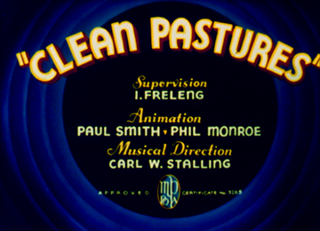
Looney Tunes is an American animated franchise produced and distributed by Warner Bros. It began as a series of short films that originally ran from 1930 to 1969, along with its partner series Merrie Melodies, during the golden age of American animation. Following a revival in the late 1970s, new shorts were released as recently as 2014. The two series introduced a large cast of characters, including Bugs Bunny, Daffy Duck, and Porky Pig. The term Looney Tunes has since been expanded to also refer to the characters themselves.

Tweety is a yellow canary in the Warner Bros. Looney Tunes and Merrie Melodies series of animated cartoons. The name "Tweety" is a play on words, as it originally meant "sweetie", along with "tweet" being an English onomatopoeia for the sounds of birds. His characteristics are based on Red Skelton's famous "Junior the Mean Widdle Kid." He appeared in 46 cartoons during the golden age, made between 1942 and 1964.

Bosko is an animated cartoon character created by animators Hugh Harman and Rudolf Ising. Bosko was the first recurring character in Leon Schlesinger's cartoon series and was the star of thirty-nine Looney Tunes shorts released by Warner Bros. He was voiced by Carman Maxwell, Johnny Murray, and Billie "Buckwheat" Thomas during the 1920s and 1930s and once by Don Messick during the 1990s.

Merrie Melodies is an American animated comedy short film series distributed by Warner Bros. Pictures. It is the partner series to Looney Tunes and featured many of the same characters. It originally ran from August 2, 1931, to September 20, 1969, during the golden age of American animation, though it was revived in 1979, with new shorts sporadically released until June 13, 1997. Originally, Merrie Melodies placed emphasis on one-shot color films in comparison to the black-and-white Looney Tunes films. After Bugs Bunny became the breakout character of Merrie Melodies and Looney Tunes transitioned to color production in the early 1940s, the two series gradually lost their distinctions and shorts were assigned to each series randomly.

Goopy Geer is an animated cartoon character created in 1932 for the Merrie Melodies series of cartoons from Warner Bros. He is a singing, dancing, piano-playing dog who is considered to be "the first Merrie Melodies star", although he only starred in three cartoons.

Piggy is the name of two animated cartoon characters in the Merrie Melodies series of films distributed by Warner Bros. The first character was a fat, black pig wearing a pair of shorts with two large buttons in the front, and his first film was You Don't Know What You're Doin'!

Warner Bros. Animation Inc. is an American animation studio which is part of the Warner Bros. Television Studios, a division of Warner Bros., which is a subsidiary of Warner Bros. Discovery and serves as the animation division and label of Warner Bros.

Tweetie Pie is a 1947 Warner Bros. Merrie Melodies cartoon directed by Friz Freleng. The short was released on May 3, 1947, and stars Tweety with Sylvester, who is called "Thomas" in this cartoon.
Edward Stacey "Tedd" Pierce III was an American screenwriter and voice actor of animated cartoons, principally from the mid-1930s to the late 1950s.

Cool Cat is a fictional cartoon character created by director Alex Lovy for Warner Bros.-Seven Arts Animation. He was the final star of the original Warner Bros. theatrical cartoons. His first appearance was in an eponymous short in 1967. He was voiced by Larry Storch. Robert McKimson took over as director for the last two cartoons in this series.

Sunday Go to Meetin' Time is a 1936 Warner Bros. Merrie Melodies cartoon directed by Friz Freleng. The short was released on August 8, 1936. The name of the short comes from the colloquial adjective "sunday-go-to-meeting", describing something appropriate for church or otherwise presentable.

Clean Pastures is a 1937 Warner Bros. Merrie Melodies cartoon directed by Friz Freleng. The short was released on May 22, 1937.

I Taw a Putty Tat is a 1948 Warner Bros. Merrie Melodies animated cartoon directed by Friz Freleng. The short was released on April 1, 1948, and stars Tweety and Sylvester.

Bad Ol' Putty Tat is a 1949 Warner Bros. Merrie Melodies animated cartoon directed by Friz Freleng. The short was released on July 23, 1949, and stars Tweety and Sylvester.
Trip For Tat is a 1960 Warner Bros. Merrie Melodies animated short directed by Friz Freleng. The short was released on October 29, 1960, and stars Tweety and Sylvester.

Room and Bird is a 1951 Warner Bros. Merrie Melodies animated short directed by Friz Freleng. The short was released on June 2, 1951, and stars Tweety and Sylvester.
Due to the success of Space Jam in 1996, Warner Bros.' Looney Tunes were revamped as a series with the release of multiple new expansions of the canon including movies, theatrical shorts, and television series.
Inki and the Minah Bird is a 1943 Merrie Melodies short directed by Chuck Jones. The short features Inki and was released on November 13, 1943.
The Little Lion Hunter is a Warner Bros. Merrie Melodies cartoon released to theaters on October 7, 1939. This short was the first of a series of five films featuring the Inki and mynah bird characters.














